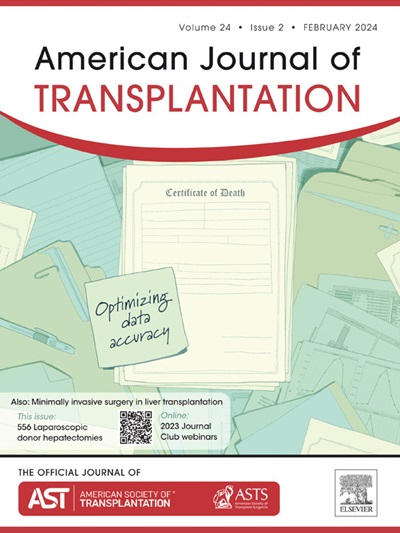Probable antibody-mediated rejection in kidney transplantation is a rare and challenging phenotype to define: Findings from a single-center study
IF 8.9
2区 医学
Q1 SURGERY
引用次数: 0
Abstract
The Banff 2022 consensus introduced probable antibody-mediated rejection (AMR), characterized by mild AMR histologic features and human leukocyte antigen (HLA) donor-specific antibody (DSA) positivity. In a single-center observational cohort study of 1891 kidney transplant recipients transplanted between 2004 and 2021, 566 kidney biopsies were performed in 178 individual HLA-DSA–positive transplants. Evaluated at time of the first HLA-DSA–positive biopsy of each transplant (N = 178), 84 of the 178 (47.2%) of first biopsies were scored as no AMR, 22 of the 178 (12.4%) as probable AMR, and 72 of the 178 (40.4%) as AMR. The majority (77.3%) of probable AMR cases were first diagnosed in indication biopsies. Probable AMR was associated with lower estimated glomerular filtration rate (mL/min/1.73m2) than no AMR (20.2 [8.3-32.3] vs 40.1 [25.4-53.3]; P = .001). The one-year risk of (repeat) AMR was similar for probable AMR and AMR (subdistribution hazard ratio (sHR), 0.99; 0.42-2.31; P = .97) and higher than after no AMR (sHR, 3.05; 1.07-8.73; P = .04). Probable AMR had a higher five-year risk of transplant glomerulopathy vs no AMR (sHR, 4.29; 0.92-19.98; P = 06), similar to AMR (sHR, 1.74; 0.43-7.04; P = .44). No significant differences in five-year risk of graft failure emerged between probable AMR and AMR (sHR, 1.14; 0.36-3.58; P = .82) or no AMR (sHR, 2.46; 0.78-7.74; P = .12). Probable AMR is a rare phenotype, however, sharing significant similarities with AMR in this single-center study. Future studies are needed to validate reproducible diagnostic criteria and associated clinical outcomes to allow for defining best management of this potentially relevant phenotype.
肾移植中可能出现的抗体介导的排斥反应是一种罕见且难以界定的表型:一项单中心研究的结果。
班夫 2022 共识引入了可能的抗体介导排斥反应(probable AMR),其特点是轻度 AMR 组织学特征和 HLA-DSA 阳性。在一项针对 2004-2021 年间移植的 1891 名肾移植受者的单中心观察性队列研究中,对 178 例 HLA-DSA 阳性的肾移植受者进行了 566 次肾活检。在对每例移植(178 例)进行首次 HLA-DSA 阳性活检时进行评估,84/178(47.2%)例首次活检结果为无 AMR,22/178(12.4%)例可能为 AMR,72/178(40.4%)例为 AMR。大部分(77.3%)疑似 AMR 病例是在指征活检中首次确诊的。可能的 AMR 与 eGFR(ml/min/1.73m2)低于无 AMR 相关(20.2 [8.3-32.3] vs. 40.1 [25.4-53.3]; p=0.001)。可能的 AMR 和 AMR 的一年(重复)AMR 风险相似(sHR 0.99;0.42-2.31;p=0.97),但高于无 AMR 后(sHR 3.05;1.07-8.73;p=0.04)。与无 AMR 相比(sHR 4.29; 0.92-19.98; p=0.06),可能 AMR 的五年移植肾小球病风险更高,与 AMR 相似(sHR 1.74; 0.43-7.04; p=0.44)。可能的AMR与AMR(sHR 1.14; 0.36-3.58; p=0.82)或无AMR(sHR 2.46; 0.78-7.74; p=0.12)之间的五年移植失败风险无明显差异。可能的 AMR 是一种罕见的表型,但在这项单中心研究中与 AMR 有着显著的相似性。未来的研究需要验证可重复的诊断标准和相关的临床结果,以确定这一潜在相关表型的最佳管理方法。
本文章由计算机程序翻译,如有差异,请以英文原文为准。
求助全文
约1分钟内获得全文
求助全文
来源期刊
CiteScore
18.70
自引率
4.50%
发文量
346
审稿时长
26 days
期刊介绍:
The American Journal of Transplantation is a leading journal in the field of transplantation. It serves as a forum for debate and reassessment, an agent of change, and a major platform for promoting understanding, improving results, and advancing science. Published monthly, it provides an essential resource for researchers and clinicians worldwide.
The journal publishes original articles, case reports, invited reviews, letters to the editor, critical reviews, news features, consensus documents, and guidelines over 12 issues a year. It covers all major subject areas in transplantation, including thoracic (heart, lung), abdominal (kidney, liver, pancreas, islets), tissue and stem cell transplantation, organ and tissue donation and preservation, tissue injury, repair, inflammation, and aging, histocompatibility, drugs and pharmacology, graft survival, and prevention of graft dysfunction and failure. It also explores ethical and social issues in the field.

 求助内容:
求助内容: 应助结果提醒方式:
应助结果提醒方式:


